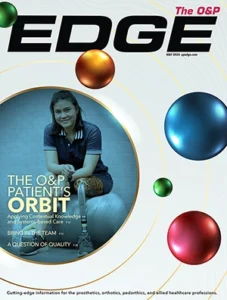Thank you for all of your responses.
Once again I am surprised by the ability of our so called “disabled”
amputees. The patient from my initial enquiry had very little trouble
donning an otto bock TF silicone liner with one arm and no donning aids. He
also converted to an ischial/ramal containment socket with very little
discomfort. So far so good… It wont work all the time, but this shows it
is always worth a shot.
Below are your responses.
We’ve had a couple of cases of fitting silicon liners to people with a non
functional UL. They have been TTA but the principle is the same. we made
donning
aids to hold the liner allowing them to pull it on one handed. Basically you
mount a shuttle lock on some appropriate structure onto which they invert
the
liner, position their stump against the liner and roll on. I’ve done a
portable
one. I ‘ve heard of them being mounted on door frames. I think I saw one in
POI
where the device was rested on a chair then the pt leaned on to it which may
be
better for a transfem.
Also our experience with Seal-Ins has been quite positive if you need to
save
build height, maybe not as stable as a clutch lock though.
hope this helps
all the best
Geoff
applying a gel liner with one hand is an incredibly difficult task unless
the patient has some function in his contralateral arm/hand. Does he use a
UE prosthesis?
Can he use his umeral residuum to assist? ie does he have the trunk
flexibility to get his arm down to the liner?
If you have an a tame OT in capivity up there, they should be able to teach
him to do it.
Richard Ziegeler P&O, OT (Australia)
Greg, Absolutely try silicone roll on. Use one of the lighter ones for
easier application and give it to him for a week to have him learn how he
can put it on with the one hand and a prosthesis if he wears one. If it is
flexible enough, he should be able to figure out how to apply it. Even if
he doesn’t wear and arm prosthesis, he probably will figure out how to do
it. Also I love pins, but don’t rule out a lanyard. OWW has a great system
that may be easier for him to pull into.
Karl Entenmann, CPO
You can make the donning easier if you make a donnig aid. Take a peice of
6inch PVC pipe and cut into 12inch section. Smooth and buff for rolled
edges. Take the liner an reflect it onto the pipe and have him step into the
pipe and instant liner application. Yes he should be able to apply the liner
with one hand . It takes practice but it will help the transition into the
liner suspension. Good luck.
Brian Moore CPO
I have worked with unilateral and bilateral upper extremity amputees who
have
been able to don and doff roll on lower extremity liners. Otto Bock TF
liners seem
to be the easiest to roll on because of the structural stability afforded by
the silicone
and outer cover. Also the outer cover slides easily over itself to
facilitate donning.
A good liner/ socket attachment system for your patient may be the KISS
system.
You can see it at http://www.kiss-suspension.com . This system will prevent
pistoning and rotation.
-Lee
Chances are that even with a humeral amputation your patient will, with a
little determination, be able to don and doff a silicone liner. I’ve found
that the simplicity of the seal-in system is always a plus. The possibility
of switching over to an endo pros. may appeal to him from the standpoint of
weight as well. If he’s a K3+ you may want to consider the Rheo
knee-allegedly it’s for higher activity patients than the C-Leg but it does
weigh a bit more. One thing to reconsider is the valve you choose to use if
you go with the seal-in system. A higher volume valve is more user friendly
for the patient in that it allows them to doff the socket quicker and with
less effort.
hope this helps
JKB-Michigan
I think that you are right about the suction and that the past sockets just
did not fit. On this type of patient suction works exceptionally well,
liners are the next best option, the seal in works well but there are a few
things that need to be checked first. The residuum needs to be stable and
donning is not easy, it usually needs two hands but not always. Belts for me
are very very unusual especially on a relatively young patient and active.
Suction using either the Hoyt UCLA socket design or the Marlo socket works
exceptionally well. Ensure that the C-Leg is properly set up and that the
patient is well educated in it’s ability and knows what to expect, this is
the major reason for rejection and that is not necessary as it is a great
leg.
Feel free to call me on SKYPE if you have any questions.
Best wishes
Gary Seaman
It is very difficult to change an old wearer like that. There are so many
things in that socket that feel like home to him. I would probably say to
him that you will probably go back to the socket system he has, but you
would like to try something different. Chances are you will not be the
first one who has said that to him. You can ask him how many others tried.
Personally I would upgrade the knee and foot component if you feel it would
make a difference. I did not understand if the shoulder strap was being
used on his TF or his TH.
Good Luck,
Rick Feldman,CPO
Thanks again….. good luck to all




